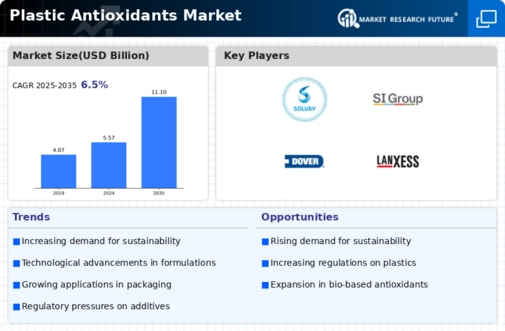Top Industry Leaders in the Plastic Antioxidants Market

The plastic antioxidants market, where invisible heroes guard against polymer degradation, is a bustling battlefield where chemical giants and niche players clash for control. From ubiquitous polyethylene to high-performance engineering plastics, antioxidants play a crucial role in extending shelf life, enhancing performance, and ensuring plastic products live up to their potential. Let's delve into the intricate layers of this market, exploring the strategies, factors impacting market share, recent developments, and its overall landscape.
Strategies Adopted: Protecting Plastics, Protecting Profits:
-
Innovation Alchemists: Industry giants like BASF, Lanxess, and Chemours invest heavily in R&D, developing next-generation antioxidants with greater efficacy, longer lifespan, and improved compatibility with specific polymers. Think tailored antioxidants for high-heat applications, biodegradable options for sustainable plastics, and flame-retardant formulations for enhanced safety. -
Cost-Conscious Champions: Regional players like Zhejiang Hisun Biomaterials and Tianjin Green Bio focus on affordability, utilizing efficient production processes and readily available raw materials to cater to price-sensitive segments and emerging markets. This strategy ensures their antioxidants reach a wider audience. -
Niche Specialists: Smaller players carve out their niches by specializing in specific polymer applications or industries. Some focus on antioxidants for food packaging, ensuring safety and compliance, while others cater to the growing demand for high-performance antioxidants for automotive and aerospace applications. This targeted approach allows them to excel in specialized areas.
Factors Fueling the Market Growth:
-
Polymer Proliferation: The ubiquitous presence of plastics across diverse industries, from packaging and construction to automotive and electronics, fuels the demand for antioxidants to protect these materials from degradation. -
Sustainability Spotlight: Consumer and regulatory pressure towards sustainable plastics is pushing the development and adoption of bio-based, biodegradable, and non-toxic antioxidants. -
Performance Prowess: Advancements in antioxidant technology lead to innovative functionalities like UV protection, anti-fogging properties, and improved flame retardancy, expanding market potential. -
Regulations & Safety: Stringent regulations on food packaging and toy safety necessitate the use of high-purity, food-grade antioxidants, creating a significant market segment for compliant solutions.
Key Players Plastic antioxidants market are BASF SE(Germany), Solvay(Belgium), SI Group, Inc(U.S.), Dover Corporation (U.S.), SAKAI CHEMICAL INDUSTRY CO.,LTD(Japan), Evonik Industries AG(Germany), LANXESS( Germany), Trigon Antioxidants Pvt. Ltd.( India), Krishna Antioxidants Pvt. Ltd( India), Shandong Linyi Sunny Wealth chemicals Co.,Ltd (China), among others.
Recent Developments:
October 2023: BASF unveils a new line of antioxidants with enhanced heat resistance, targeting applications in high-temperature environments like automotive engines and aircraft parts.
November 2023: Lanxess partners with a research institute to develop bio-based flame-retardant antioxidants, offering a sustainable alternative for improving fire safety in plastic products.
December 2023: Chemours expands its production capacity in Asia, aiming to capitalize on the region's booming electronics and automotive industries and growing demand for high-performance antioxidants.
January 2024: Zhejiang Hisun Biomaterials collaborates with a university to develop biodegradable antioxidants from natural sources, opening new doors for sustainable solutions in the packaging industry.

